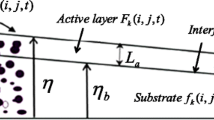Abstract
Two kinds of bank erosion mechanisms were analyzed, including fluvial and non-fluvial controlled mechanisms, and mechanical methods of simulating the erosion processes of cohesive, non-cohesive and composite riverbanks were improved. Then a two-dimensional numerical model of the channel deformation was developed, consisting of a 2D flow and sediment transport submodel and bank-erosion submodels of different soil riverbanks. In the model, a new technique for up dating the bank geometry during the bed evolution was presented, which combines closely two kinds of submodels. The proposed model is capable of not only predicting the processes of flood routing and longitudinal channel deformation in natural rivers, but also simulating the processes of lateral channel deformation, especially the processes of lateral erosion and failure of cohesive, non-cohesive and composite river banks.
Similar content being viewed by others
References
Xie, J. H., Ding, J. S., Wang, Y. H., Fluvial Processes and Training (in Chinese), Beijing: China Water and Power Press, 1990.
Zhao, Y. A., Zhou, W. H., Fei, X. J. et al., Basic Laws of Fluvial Processes in the Lower Yellow River (in Chinese), Zhengzhou: Yellow River Water Conservancy Press, 1998.
ASCE Task Committee on Hydraulic, Bank Mechanics, and Modeling of Riverbank Width Adjustment, River width adjustment, II. Modeling, Journal of Hydraulic Engineering ASCE, 1998, 124(9): 903–918.
Osman, A. M., Thorne, C. R., Riverbank stability analysis, I. Theory, Journal of Hydraulic Engineering, ASCE, 1988, 114(2): 134–150.
Daiby, S. E., Thorne, C. R., Numerical simulation of widening and bed deformation of straight sand-bed rivers, I. Model development, Journal of Hydraulic Engineering, ASCE, 1996, 122(4): 184–193.
Daiby, S. E., Alabyan, A. M., Van de Weil, M. J., Numerical simulation of bank erosion and channel migration in meandering rivers, Water Resources Research, 2002, 38(9): 1–19.
Nagata, N., Hosoda, T., Muramoto, Y., Numerical analysis of river channel processes with bank erosion, Journal of Hydraulic Engineering, ASCE, 2000, 126(4): 243–252.
Duan, J. G., Wang, S. Y., The applications of the enhanced CCHE2D model to study the alluvial channel migration processes, Journal of Hydraulic Research, 2001, 39(4): 469–480.
Wang, J. C., Wan, Z. H., Numerical modeling of the fluvial processes in the Lower Yellow River, Journal of Chinese Hydraulic Engineering (in Chinese), 1999, (2): 13–18.
Zhang, H. W., Study on Fluvial Mechanics (in Chinese), Zhengzhou: Yellow River Water Conservancy Press, 1999.
Chen, W. H., Wang, C. H., The calculation of flow field in rivers by the orthogonal coordinates and “condensation” technique, Journal of Chinese Hydraulic Engineering (in Chinese), 1988, 6: 18–25.
Zheng, B. M., Zhao, X., Computational Hydrodynamics (in Chinese), Wuhan: Wuhan University Press, 2001.
Xia, J. Q., Wang, G. Q., Non-oscillatory computational schemes for the vertical plane 2D suspended sediment transport equation, in the Proceedings of 29th IAHR Congress (Theme D, Vol. II) (eds. Chinese Society of Hydraulic Engineering), Beijing: Tsinglua University Press, 2001, 26–34.
Thorne, C. R., Hey, R. D., Newson, M. D., Applied Fluvial Geomorphology for River Engineering and Management, Chichester: John Wiley and Sons, 1997, 137–167.
Thorne, C. R., Tovey, N. K., Stability of composite riverbanks, Earth Surface Processes and Landforms, 1981, 6: 469–484.
Hagerty, D. J., Piping/sapping erosion, I. Basic considerations, Journal of Hydraulic Ergineering, ASCE, 1991, 117(8): 991–100S.
Research Group of Bank Caving in the Guanting Reservoir, Study on Bank Caving in Reservoirs (in Chinese), Beijing: Hydraulic and Hydropower Press, 1958.
Chien, N., Zhang, R., Zhou, Z. D., Fluvial Processes (in Chinese), Beijing: Science Press, 1989.
Ikeda, S., Parker, G., Kimura, Y., Stable width and depth of straight gravel rivers with heterogeneous bed materials, Water Resource Research, 1988, 24(9): 713–722.
Pizzuto, J. E., Numerical simulation of gravel river widening, Water Resource Research, 1990, 26(9): 1971–1980
Fukuoka Shoji, Mechanisms of the erosion processes of natural dike banks, Express Water Resources and Hydropower Information (in Chinese), 1996, 2: 29–33.
Xia, J. O., Study on riverbank erosion mechanisms and munerical modeling (in Chinese), PhD Thesis, Beijing: Tsinglua University, 2002.
Author information
Authors and Affiliations
Corresponding author
Rights and permissions
About this article
Cite this article
Xia, J., Wang, G. & Wu, B. Two-dimensional numerical modeling of the longitudinal and lateral channel deformations in alluvial rivers. Sci. China Ser. E-Technol. Sci. 47 (Suppl 1), 199–211 (2004). https://doi.org/10.1360/04ez0017
Received:
Issue Date:
DOI: https://doi.org/10.1360/04ez0017



